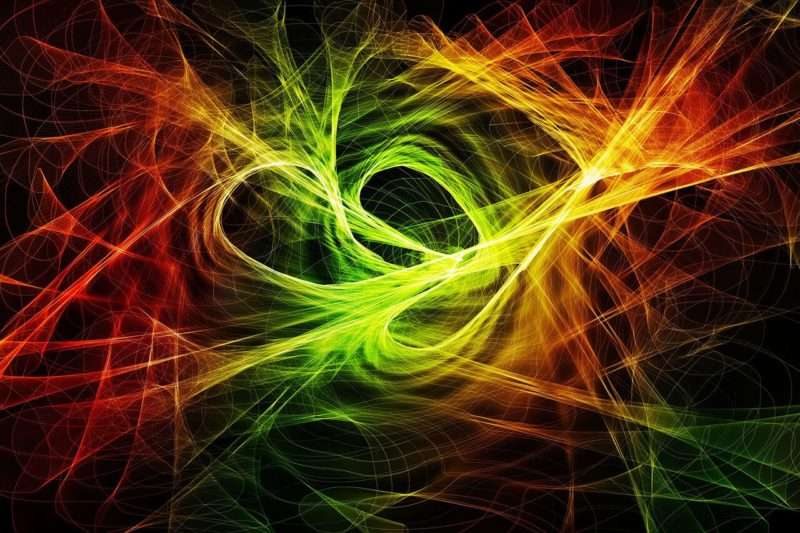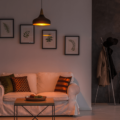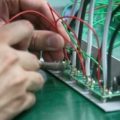‘Europe’s biggest lighting event,’ LuxLive, took place last week in London, and in addition to all the talks, awards ceremonies and exhibitions, it provided an opportunity for lighting manufacturers and developers to showcase some of their cutting-edge products and services.
From ‘Li-Fi’ lamps that deliver wireless data in their light beam, to the large scale potential of smart technology, the lighting industry is developing faster than it ever has before.
Inspired by the forward-thinking minds who are busy bringing us the next generation of lighting, we take a look at five lighting concepts that sound like they’re from the future, but which are already on their way.
Li-Fi
‘Li-Fi’ (Light Fidelity) is a new technology that allows lamps to deliver wireless data signals in their beam of visible light, potentially turning your home lighting into your internet router. Research and development into the technology has been ongoing for some time, and at this year’s LuxLive, the first-ever Li-Fi enabled luminaire was put on a show. Created by French manufacturer Lucibel and Scottish startup pureLifi, the ‘Ores’ fitting looks like a traditional downlight, except for the small black box attached to the back of it that houses the innovative Li-Fi technology.
The Ores is said to deliver up to 45 megabits of data per second, and previous tests of Li-Fi lighting suggested that the potential speeds could be much greater. With lighting giant Philips and other companies around the world investing in Li-Fi research and development, it could soon be the way all homes and businesses connect to the internet.
OLED lighting

Many might be familiar with OLED technology already, as it is used in the latest generation of smartphones and ultra-HD televisions. The acronym stands for Organic Light Emitting Diode and, as its name suggests, the technology bears a relation to the current standard of LED light bulbs that are now widely used in energy-saving light bulbs. OLED lighting differs from its predecessor because it uses an organic, carbon-based material that illuminates when a current is passed through it. It is good for televisions and smart devices because it allows for thinner screens and much deeper contrasts, with darker blacks and more vivid whites than ever before.
The use of OLED in lighting has been limited so far, primarily because of its expense. Firms such as LG are still researching ways to make the technology cheaper and more accessible, and if they succeed, it could provide the foundation for a new generation of lighting.
The way OLED works means that it can be applied to plastic sheets and foils, creating super-thin lighting panels. LG currently have a 100mm x 100mm panel available that emits 90 lumens per watt, but which is less than 1mm thick. What’s more, some of these OLED products are flexible, meaning you can wrap them and twist them into a variety of shapes. The potential for OLED lighting is huge.
Smart cities
Not long ago, we wrote about a project that several European cities are participating in to utilise smart technology on a city-wide scale. They plan to use it to monitor traffic flow, manage street lighting, optimise waste disposal, and for many other applications that could save money and energy across a range of public services. Ideas like this are gaining traction, and the ‘smart cities’ of the future may not be so far away.
Potentially, every aspect of city planning could be carefully managed, using massive volumes of data gathered from sensors fitted in key locations. Steps could be taken to ease traffic congestion in real-time; smart waste bins could tell waste disposal services if and when they need emptying, allowing collection routes to be optimised; streetlights could be tuned to reactively adjust their brightness and minimise light pollution.
The infrastructure to enable all of these technologies is, of course, not yet in place in the vast majority of cities. It may be years before such programmes are standard, but some locations are already seeing the benefits of smart technology. In the coming decades, our cities may very well work a lot differently than they do now.
Laser lighting
The only experience many people will have of lasers will be light shows at concerts, festivals and exhibitions, or laser pens that more often than not fall into mischievous hands. Our idea of lasers might soon change, however.
The inventor of the blue light LED, and one of the people that enabled the widespread use of LED lighting as we know it now, Nobel Prize-winner Dr. Shuji Nakamura, believes that lasers are the future of lighting. He founded a company last year called SoraaLaser, which develops and manufactures laser diode lighting for various industries and speciality uses. With an efficiency ten times higher than LED light bulbs, lasers are already used in the automotive industry, where manufacturers like Audi and BMW have already started to integrate the technology into car headlights.
Soon, Nakamura and others believe, laser diode lighting will be commonplace in homes and workplaces around the world. The way it is delivered – through extremely fine fibre optic cables – has the potential for great innovation. For example, the optics could be threaded into fabrics to make them glow, and the light would not need electrical wiring at all to travel from source to destination. This, combined with the efficiency of laser diodes, could revolutionise lighting, just as LED lighting has in the last decade or two.
The Internet of Things
The ‘Internet of Things’ (IoT) has been talked about for some time, but now it is really starting to gain momentum. Rather than just using it to connect your household appliances to one home network (it could do this), firms like Gooee are applying the technology on a larger, more data-driven scale. Their ‘Data Brain’ has the potential to turn whole buildings into smart spaces, using an IoT ‘ecosystem’ designed to ‘capture environmental data and human activity.’ It would primarily use sensors distributed throughout a building’s lighting system to measure the behaviour of its occupants, using this data to optimise the environment.
The data that is gathered using these sensors could be used for a variety of practical purposes: in retail stores, to measure the movement of shoppers to determine popular and unpopular zones; to utilise space in offices more effectively and improve the wellness of employees by creating the ideal lighting conditions; handing much more control of environmental settings to a building’s occupants.
This interconnectedness is the direction in which a lot of technology sectors are heading, and in many cases, lighting is key to its delivery.




